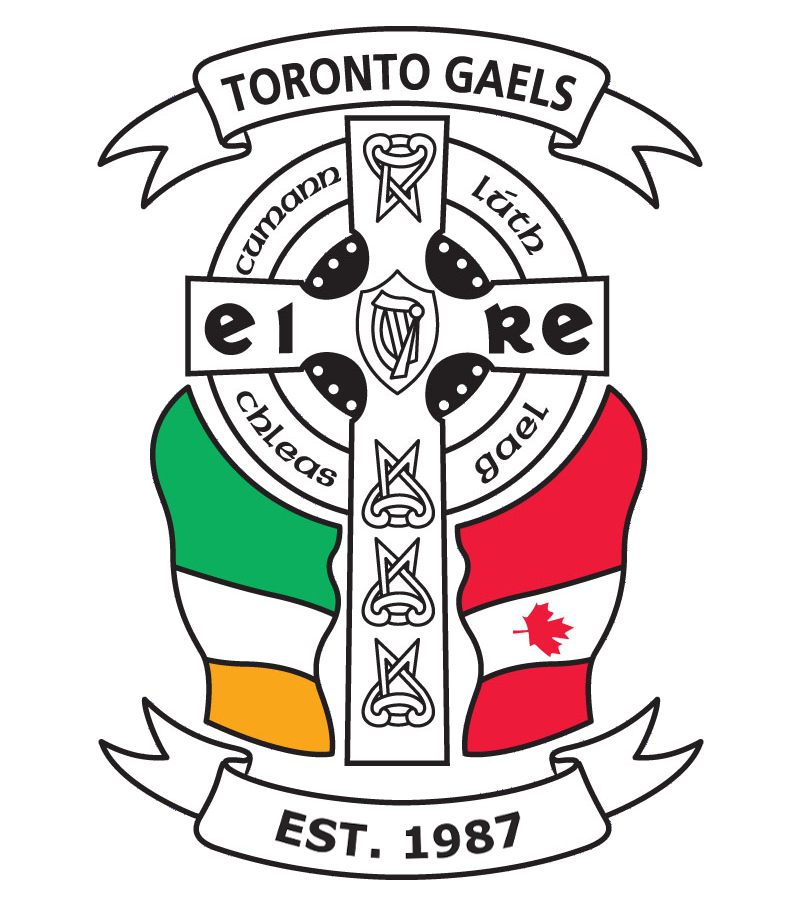Toronto Clan na Gael Hurling Club
To get involved with Toronto Clan na Gael Hurling Club email torontoclannagaelhurling@gmail.com or visit Facebook page www.facebook.com/torontoclannagaelhurling.
2016 TORONTO clan na GAEL COMMITTEE
Chairman
Kieran Boyle
Vice-Chair
Michael Cussen
Secretary
Bernie Boyle
Treasurer
????????
Registrar
????????
Committee Member
????????
Hurling explained
Hurling (Irish: Iománaíocht/Iomáint) is an outdoor team game of ancient Gaelic and Irish origin. The game has prehistoric origins, has been played for over 3,000 years, and is considered to be the world's fastest field sport. One of Ireland's native Gaelic games, it shares a number of features with Gaelic football, such as the field and goals, the number of players, and much terminology. There is a similar game for women called camogie (camógaíocht). It shares a common Gaelic root with the sport of shinty (camanachd), which is played predominantly in Scotland. In Canada, what came to be present-day ice hockey, one of the most popular and notable sports in the twenty-first-century world, was first introduced by the Micmac (Mi’kmaq) natives of Nova Scotia in the mid-1800s. The games played by these Canadian natives seem to have been inspired by the Irish game of hurling, from which it derived the nomenclature of the stick, and then dubbed as “hurley.”
The objective of the game is for players to use a wooden stick called a hurley (in Irish a camán, pronounced /come-on/) to hit a small ball called a sliotar ( pronounced /schlit-er/) between the opponents' goalposts either over the crossbar for one point, or under the crossbar into a net guarded by a goalkeeper for one goal, which is equivalent to three points. The sliotar can be caught in the hand and carried for not more than four steps, struck in the air, or struck on the ground with the hurley. It can be kicked or slapped with an open hand (the hand pass) for short-range passing. A player who wants to carry the ball for more than four steps has to bounce or balance the sliotar on the end of the stick and the ball can only be handled twice while in his possession.
Provided that a player has at least one foot on the ground, a player may make a shoulder to shoulder charge on an opponent: (a) who is in possession of the ball, or (b) who is playing the ball, or (c) when both players are moving in the direction of the ball to play it.
No protective padding is worn by players. A plastic protective helmet with a faceguard is mandatory for all age groups, including senior level, as of 2010. The game has been described as "a bastion of humility", with player names absent from jerseys and a player's number decided by his position on the field.
Each team consists of fifteen players, lining out as follows: One goalkeeper, three full-backs, three half-backs, two midfielders, three half-forwards and three full-forwards. The actual line out on the playing field is as follows:
Players wear a jersey with their team colours and number on the back. Both teams must have different colour jerseys. The goalkeepers' jerseys must not be similar to the jersey of any other player. Referees normally tog out in black jerseys, socks and togs.
Goalkeepers may not be physically challenged whilst inside their own small parallelogram, but players may harass them into playing a bad pass, or block an attempted pass.
Teams are allowed a maximum of five substitutes in a game. Players may switch positions on the field of play as much as they wish but this is usually on the instructions of team officials.
Officials for a game comprise of a referee, two linesmen (to indicate when the ball leaves the field of play at the side and to mark '45'' free kicks and 4 umpires (to signal scores, assist the referee in controlling the games, and to assist linesmen in positioning '45' frees).
A goal is signalled by raising a green flag, placed to the left of the goal. A point is signalled by raising a white flag, placed to the right of goal. A '45'/'65' is signalled by the umpire raising his/her outside arm. A 'square ball', when a player scores having arrived in the 'square' prior to receiving the ball, is signalled by pointing at the small parallelogram.
Hurling is played throughout the world, and is popular among members of the Irish diaspora in North America, Europe, Australia, New Zealand, South Africa and Argentina, and South Korea. In many parts of Ireland, however, hurling is a fixture of life. It has featured regularly in art forms such as film, music and literature. The final of the All-Ireland Senior Hurling Championship was listed in second place by CNN in its "10 sporting events you have to see live", after the Olympic Games and ahead of both the FIFA World Cup and UEFA European Football Championship. After covering the 1959 All-Ireland Senior Hurling Championship Final between Kilkenny and Waterford for BBC Television, English commentator Kenneth Wolstenholme was moved to describe hurling as his second favourite sport in the world after his first love, football (soccer). In 2007, Forbes magazine described the media attention and population multiplication of Thurles town ahead of one of the game's annual provincial hurling finals as being "the rough equivalent of 30 million Americans watching a regional lacrosse game".
RELATED LINKS
The GAA (Gaelic Athletic Association) in Ireland is the governing body for Gaelic Football and Hurling.








